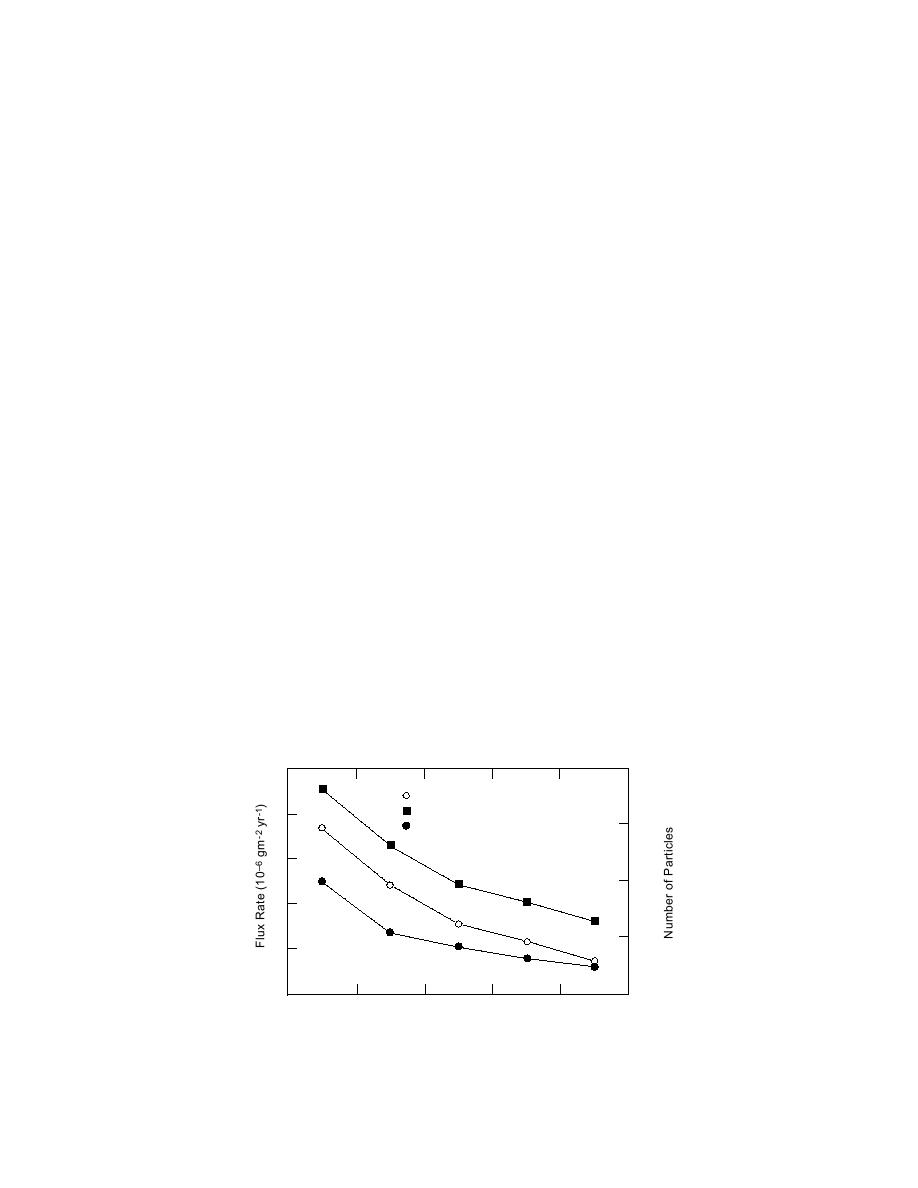
for particles larger than 400 m, we estimate that
Particulate concentrations expected
We determined the filter mesh size and required
0.15 g of the 10 g recovered, or about 1.5%, was
area using information on the size distribution and
extraterrestrial.
amounts of particulates in Antarctic ice and esti-
Maurette et al. (1987) estimated the microme-
teorite flux rate falling on Greenland ice as 6.3
mates of extraterrestrial particle concentrations in
106 g m2 yr1 for the 50300-m size range. Love
Greenland and Antarctic ice.
The number of particulates in Antarctic ice <30
and Brownlee (1993) measured the micrometeor-
m have been determined using Coulter counters
ite flux rate in space, using the Long Duration Ef-
fects Facility, as 40 (20) 106 kg yr1, or 1.2
(unpublished data from E.M. Thompson) and by
104 to 3.9 105 g m2 yr1. The difference be-
counting the number of particles from photomi-
crographs taken using a scanning electron micro-
tween the LDEF and the Greenland values sug-
scope (Higashi et al. 1990). The number of particles
gests that 5 to 15% of the particles survive atmo-
is very high: 20,000 particles/mL of water for sizes
spheric passage. Figure 4 shows the size distribu-
less than 1 m, and about 7000 particles/mL of
tion of micrometeorites expected at the SPWW
water in the 130-m size range (unpublished data
based on the Greenland flux rate. Our original es-
from E.M. Thompson). These particles are over-
timate for the diameter of the SPWW was 15 m
whelmingly terrestrial in origin. Thus, to avoid
and that 10 m of downward melting (100 years of
clogging our filter with terrestrial particles, we
deposition) would occur each year. Thus, we ex-
chose a filter fabric with a 53-m opening. This
pected that yearly collection could yield 0.11 grams
of micrometeorites, or about 105 particles larger
should limit our collection to particles larger than
about 50 m unless the filter plugs significantly.
than 50 m based on the flux rate of Maurette et
These larger particles are easy to handle and ana-
al. (1987). However, we expected the first collec-
lyze.
tion in 199596 to have three to four times this
We estimated the fraction of extraterrestrial to
amount of material because of the larger ice vol-
terrestrial particles in Antarctic ice larger than 50
ume melted to create and operate the well prior to
m using data from Maurette et al. (1991). They
our deployment.
melted 100 tons of Antarctic ice and recovered
We also expected the operation of the SPWW
about 10 grams of particulate material. This mate-
to add particulates to the well. To determine an
rial included 9000 micrometeorites 50 to 100 m
approximate count, we asked John Rand to filter
in diameter, 6500 micrometeorites 100 to 400 m
8 L of water from the SPWW through a cellulose
nitrate membrane filter with a 5-m pore size. We
in diameter, and 9 micrometeorites larger than 400
m. Assuming an average density of 2.5 g cm3,
examined the filter both optically and with a scan-
and taking 75 m as the average diameter for the
ning electron microscope. Eleven percent of the
50- to 100-m-sized particles, 250 m for the 100-
surface area of the filter yielded 15 fibers and 568
particles, most in the 510-m size range. Forty-
to 400-m particles, and 400 m as the diameter
106
5
No. of Particles Released in 1 Year
No. of Particles in First Year
4
105
Flux Rate (Maurette et al. 1987)
3
104
2
103
1
102
0
50
100
150
200
250
300
Mean Particle Diameter (m)
Figure 4. Number and size distribution of particles >50 m estimated for
the bottom of the SPWW.
6



 Previous Page
Previous Page
